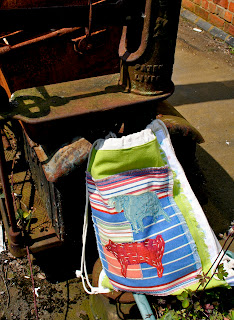Our walk started at the Kelmarsh car park and we were all curious about the almost lunar base structures in the area next to it - it was the former railway access to the
Kelmarsh depot "
a 1960 map that indicates "Air Ministry Petrol Storage Depot" with 3 sidings immediately to the east of the station, and another siding to the north-east of the railway line.". Andrew (ex-RAF) spotted an A Frame and bomb winch which looked strangely like a child's swing!
In 1870-72, John Marius Wilson's Imperial Gazetteer of England and Wales described Arthingworth like this:
"ARTHINGWORTH, a parish in the district of Market-Harborough, and county of Northampton; on an affluent of the river Nen, 1¾ mile NW of Kelmarsh r. station, and 5 S by E of Market-Harborough. Post Town, Kelmarsh under Northampton. Acres, 2,030. Real property, £3,056. Pop., 275. Houses, 53. The property is divided among a few. Arthingworth Hall is the seat of the family of Rokeby. The parish is a meet for the Pytchley hounds. The living is a rectory in the diocese of Petersborough. Value, £323. Patron, the Rev. H. R. Rokeby. Charities, £39."
from A Vision of Britain Through Time
It wasn't the most photogenic of days, the grey cloud cover hardly lifted but it was mild and thankfully we were spared the rain.
It was a slow walk, as people stopped singlely
or in small groups to look at small details,
 Photo by Meriel White
Photo by Meriel White
listen to bird song and catch up on life events.
Industry imitates nature
Our walk into Arthingworth took us past what looked like an agricultural machine graveyard, still and rusting equipment being overtaken by grasses and weeds.
Sort of Sci-Fi!
Taking a moment to consult the OS map
as a cyclist and dog spin past the rapeseed field
"
Arthingworth in 1908 -
Arthingworth lies 5 miles to the south of Market Harborough. This image is a copy photograph of a postcard produced by Northampton photographer A. Addington. The village is very compact, with all the houses clustered around the church of St. Andrew. Arthingworth is first recorded in the Doomsday Book as Arniworde meaning enclosure of Earnes people."
Some more Arthingworth history can be found here
Cottage garden
I spy lovely glass!
Hold still!
"No one knows precisely how old our village church is, but it seems certain part of the present building was standing here in the 12th century.
The south chapel and aisle were probably added in the 13th and 14th centuries.
The tower is of the 15th century.
The whole church was extensively renovated in Victorian times. The roof of the chancel is a particularly good example of a Victorian reproduction of medieval work, although owing to lack of sufficient funds at the time it was never painted as the architect had envisaged.
A sixth bell was installed for the Millennium, and now bellringers come to Arthingworth to ring a a full peal. The funding for this was grant-aided and additional money raised by public subscription and private donations.
We welcome you to our church and, in a building hallowed by over 700 years of Christian worship, invite you to meditate on St. Andrew - the fisherman who became the 'fisher of men' - for Christ."
(text taken from Notice inside church)
On our walk out of the village we were passed by this tractor load of village revellers - early Jubilee celebrations, birthday party - we couldn't be sure but they seemed to be having a good time!
Heading back towards the Bridge
near the site of Kelmarsh station
It was a good walk and a lovely afternoon - really it didn't matter too much about the weather - more light and blue skies would have been wonderful, but the great thing is this walk, this countryside is there for us to explore any time the fancy takes us!
You can see more images by the walkers here

















































